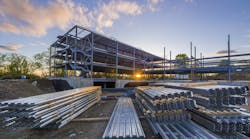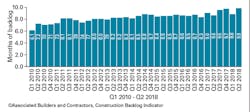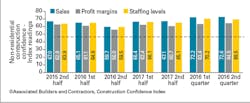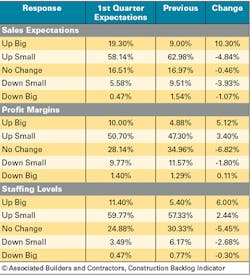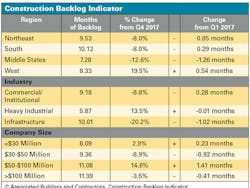Latest from Contractor Marketplace
Sponsored
Overall, the U.S. economic picture was solid in 2018, with the unemployment rate steady at 3.7 percent and available jobs up — 7.1 million as of Oct. 31. Closer to home, as of November, the construction industry added an average of 27,000 jobs each month over the prior year.
Think-tank and research group The Conference Board released it’s latest Leading Economic Index, which shows increases in the last few months of 2018 but does see signs of a slowdown in 2019.
“The U.S. LEI increased slightly in October, and the pace of improvement slowed for the first time since May,” says Ataman Ozyildirim, director of economic research and global research chair at The Conference Board. “The index still points to robust economic growth in early 2019, but the rapid pace of growth may already have peaked. While near-term economic growth should remain strong, longer-term growth is likely to moderate to about 2.5 percent by mid- to late 2019.”
Talk of steep tariffs on the trade front has some people concerned in the industry, as uncertainty lingers over what the Trump administration will ultimately decide to do.
Yet many in the construction industry are cautiously optimistic about the economy in 2019. The one area of concern is the residential market, which showed some signs of slowing down in the fourth quarter of 2018 and is expected to continue into 2019. It is perplexing to some, as the demographics seem to indicate room for growth.
“When you look at demographics, immigration and all the other things that cause demand for housing, those factors are still there,” notes Dale Stroud, senior director of offerings and marketing at Uponor North America. “Yes, pricing is an issue in some parts of the country, but financing has improved regarding availability. It’s a little bit disconcerting when you look at what’s going on.”
He adds that while the National Association of Home Builders’ Housing Market Index is still above 50, which indicates confidence in the market, it dropped eight points in November. “It indicates that home builders are getting a little bit less optimistic than they were,” Stroud says. “So these different things are almost conflicting. Some indicators point to a very good housing market. Others show some concerns that maybe we’ll see less growth.”
Up to the third quarter of 2018, single-family and multifamily housing starts were up by almost 6 percent. But the experts we talked to say the United States is building about 1.27 million housing units a year when the industry should be at between 1.4 million and 1.5 million housing units. In 2019, experts are predicting only a modest increase in residential construction.
“In residential units, I believe we’re expecting a very modest increase, maybe about 5 percent or so, about 50,000 units,” notes Manuel Gutierrez, a former market researcher and economic analyst with Kohler Co. who now runs his own research and economics business. “But the dollar value is higher because of price increases and perhaps a shift to higher-priced units. In value, we may see something closer to 9 or 10 percent, but in units we expect much lower. It’s still up in the air. And mortgage rates are a little more favorable.”
The Plumbing-Heating-Cooling Contractors—National Association is looking at the same slower-growth residential picture. “Based on forecasts we’ve seen, we’re anticipating slower growth for construction next year than in 2018,” explains PHCC President Ken Nielsen. “As an economist told us during CONNECT 2018, ‘Mild headwinds are coming your way.’ There already has been a decline in single-family housing, which is expected to affect commercial next. However, reports indicate contractors in light commercial work will have a good year.
“To prepare for these changes, PHCC has advised our contractor members to pay attention to leading industry indicators and their business trends, especially signs of slow growth, and take steps to prepare for a slower economy.”
Construction research and consultant group Zelman & Associates also sees housing as a low point in 2019.
“October was the worst month we’ve seen probably going back to 2011, I believe, for new order growth; the fourth quarter of 2018 is pretty disappointing for orders for home builders,” explains Dennis McGill, Zelman’s director of research. “And that ultimately is going to be feeding into the early part of 2019 for anybody involved in the start or completion of a home. We believe most of the pressure is driven by higher mortgage rates, although that’s going to inflect more positively next year; we’ve already seen rates go down a bit.”
He adds that it typically it takes three or four quarters for the consumer to adjust and re-engage before the home building industry will see growth again. “So 2019 will be a year we’re likely to see a step down in building products revenue growth because of this lag effect,” he says. (Contractors can keep up with housing trends by signing up to a 60-day free trial of Zelman’s Z Report at www.zelmanassociates.com/products-services/z-report.)
Home remodeling, however, has been on the rise — the “bright spot” in residential, Gutierrez says. In 2018, it was running about 7 to 8 percent higher than the previous year. “Residential remodeling over the last 12 months increased by almost 24,000 workers, which is about 9 percent of the total,” he explains. “Remodeling is more robust than the general trades because general trades get involved in both remodeling projects and new construction projects.”
On the nonresidential side, Associated Builders and Contractors CEO Mike Bellaman says his members — open shops primarily working in the commercial and industrial markets — are positive about the coming year; the group’s 2018 second-quarter Construction Backlog Indicator (the amount of work under contract but yet to be completed) reports a record-high of 9.9 months of backlog. This number is up 12.2 percent from 2018’s first quarter and up 14 percent from the same period last year.
Over all sectors, construction spending rose to a historical level, he notes, and ABC is predicting the year will end at $1.3 trillion.
“That’s the entire market and we think we’re going to be right around that again in 2019,” Bellaman says. “Certain segments will be up and down. Single-family residential will probably be down, commercial office might be a little bit down, retail might be a little bit down. But industrial probably will be a little bit up, as well as health care.”
Infrastructure, Taxes, Tariffs
With all the turmoil going on in Washington between political parties — between the administration and Congress — will a Democratic-controlled House increase the gridlock?
“The one positive story I believe we need to focus in on, from the contractor perspective, is the administration and the House are finding commonality about what they want to do on infrastructure,” explains Mark Riso, PHCC’s vice president of legislative affairs. “Legislators are starting to understand that when we talk about infrastructure, water systems are a part of the discussion.”
He notes that over the past two years, funding has increased for loan programs municipalities can use to help rebuild their water systems.
Bellaman says his members are focused on taxes and making cuts permanent. “Construction was historically one of the highest taxed industries in the country, so we’re going to fight hard for many of the aspects in Tax 2.0,” he explains. “One of the keys to CEO confidence is predictability. Making those tax cuts permanent means CEOs can count on the current tax structure. Another big benefit to our industry is raising the debt tax limit. Any time you can put another dollar in a worker’s paycheck on Friday, that’s great news.”
Not only do the high tariffs — 25 percent on certain goods effective Jan. 1 — affect plumbing products and supplies, it affects regular products people use in their businesses.
Tariffs and trade have dominated the news in recent months. And while some in the industry are behind the administration’s trade policy, plumbing manufacturers are deeply concerned.
“In general, the imposition of tariffs has been detrimental to the plumbing industry,” says Kerry Stackpole, CEO of Plumbing Manufacturers International. “We’re part of the free trade coalition which has encouraged the president to find a middle ground with President Xi of China, to bring this thing to some sort of resolution because we think in the long term, not only does it impact manufacturers, but it impacts retailers, it impacts farmers. We’ve been encouraging the administration to find a more targeted approach because broad-based tariffs whack everybody.”
He notes that not only do the high tariffs — 25 percent on certain goods effective Jan. 1 — affect plumbing products and supplies, it affects regular products people use in their businesses.
“One of the unrecognized side effects is the cost of products imported from China and other countries, Canada among them, are increasing the cost of business operations,” Stackpole explains. “There are so many different things made or manufactured overseas that I believe businesses are seeing cost increases across the board.
“The idea that if you’re not manufacturing or buying something overseas, the tariffs may not impact you as much is probably true, but you’re also impacted by other costs and other influences that are occurring.”

Kelly L. Faloon | Freelance Writer/Editor
Kelly L. Faloon is a contributing editor and writer to Contractor, Contracting Business magazine and HPAC Engineering and principal of Faloon Editorial Services. The former editor of Plumbing & Mechanical magazine, Faloon has more than 26 years of experience in the plumbing and heating industry and more than 35 years in B2B publishing. She started a freelance writing and editing business in 2017, where she has a varied clientele.
Faloon spent 3 1/2 years at Supply House Times before joining the Plumbing & Mechanical staff in 2001. Previously, she spent nearly 10 years at CCH/Wolters Kluwer, a publishing firm specializing in business and tax law, where she wore many hats — proofreader, writer/editor for a daily tax publication, and Internal Revenue Code editor.
A native of Michigan’s northern Lower Peninsula, Faloon is a journalism graduate of Michigan State University. You can reach her at [email protected].

